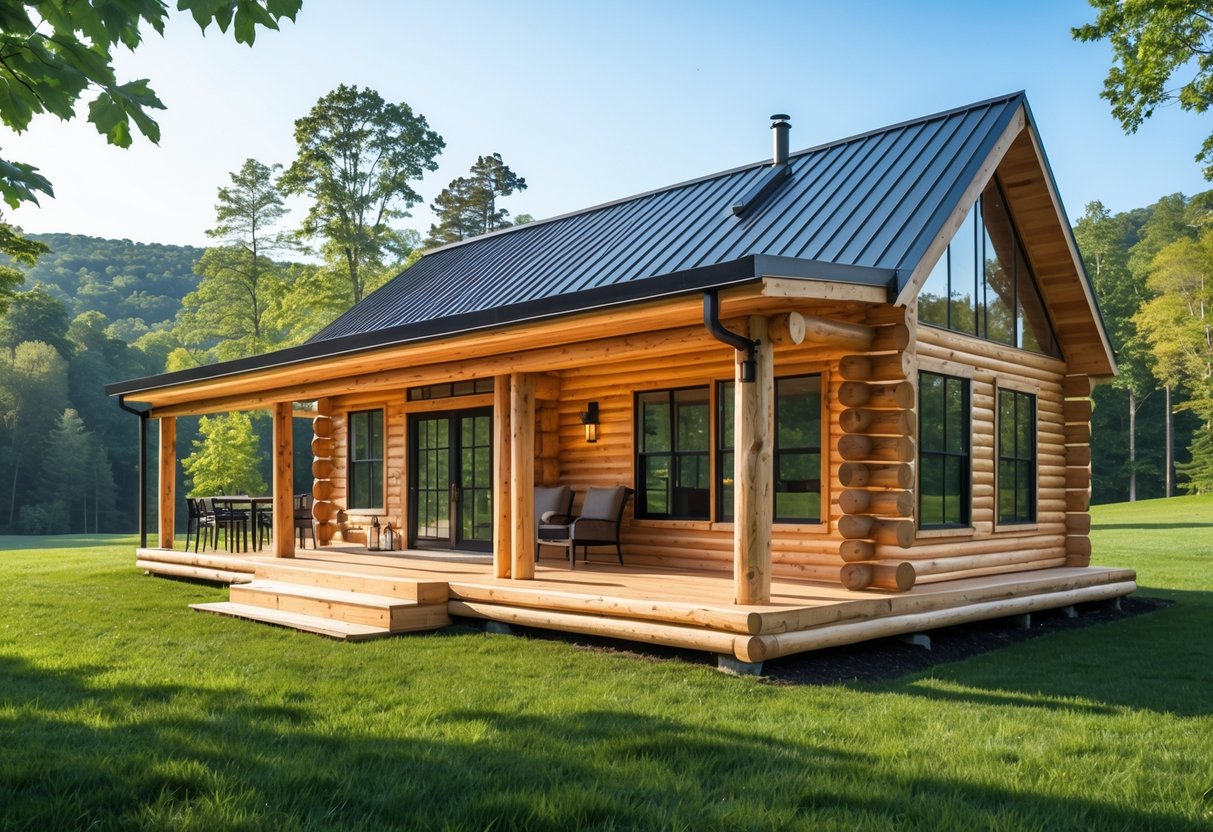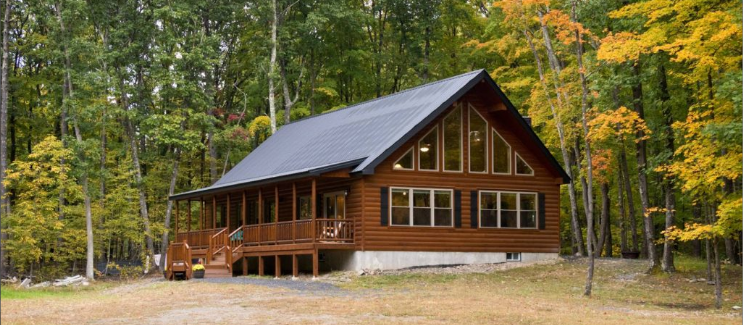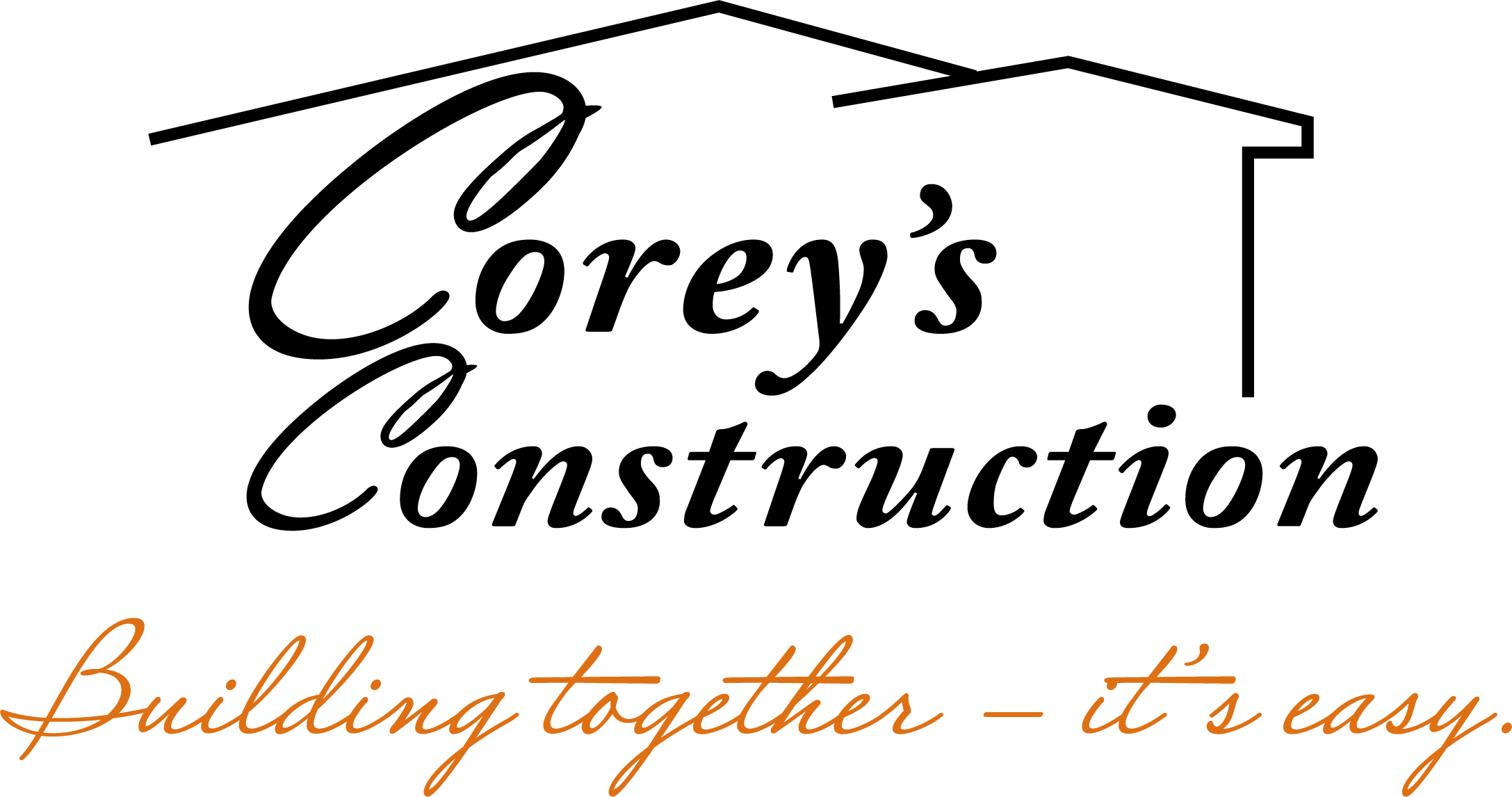Buying a modular home can feel exciting, but it’s also one of the biggest financial decisions you’ll make. You want your investment protected from the start. You should never pay the modular factory before your home is set on the foundation because doing so removes your leverage and exposes you to unnecessary risk. Waiting until the home is properly installed ensures you get what you paid for and that the work meets your expectations.
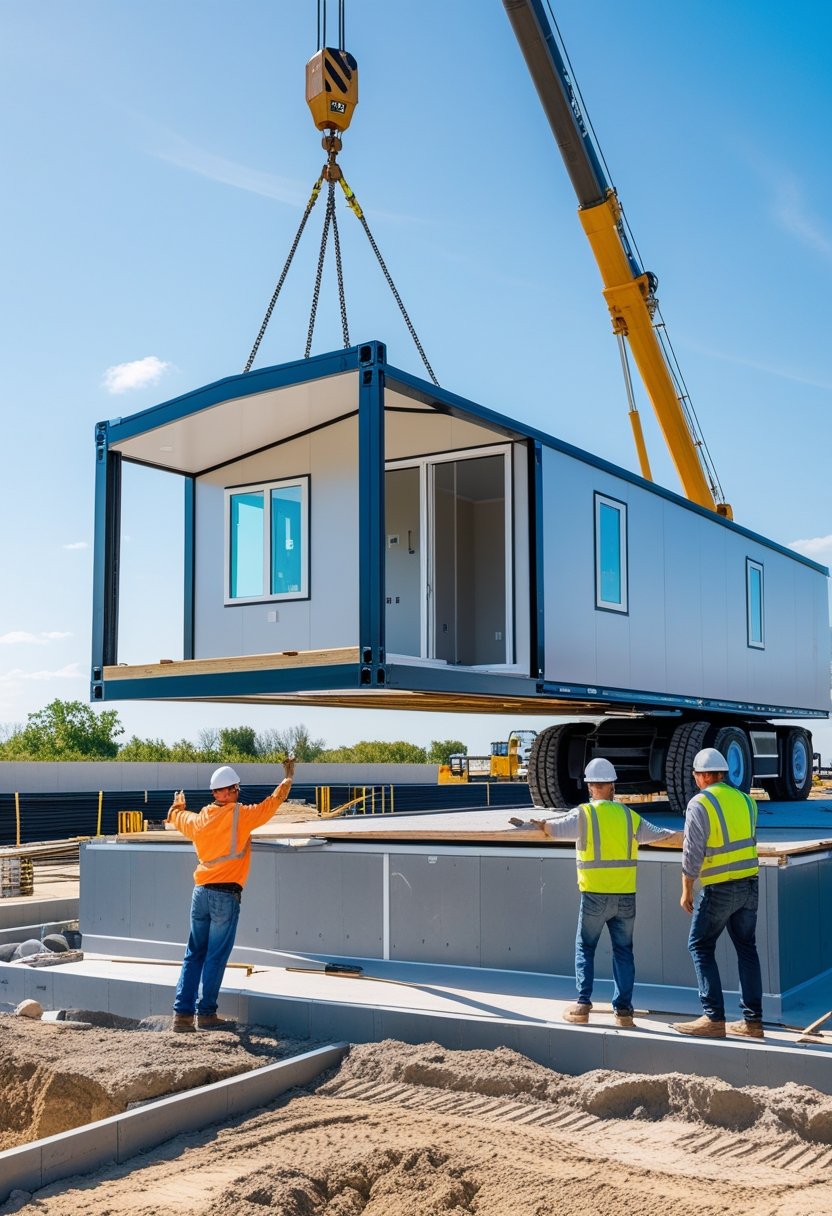
When you delay payment until the home is set, you keep control over the project. This approach helps confirm that the structure arrives undamaged and meets all agreed-upon standards. As explained in this guide on modular home payments, holding off on payments until installation motivates the factory to meet deadlines and maintain quality.
Skipping early payment also protects you from legal and financial complications. If problems arise during transport or setup, you can address them before releasing funds. This simple step can save you time, stress, and money.
Key Takeaways
- Wait to pay until your modular home is set on its foundation.
- Holding payments keeps leverage and ensures quality work.
- Delaying payment reduces financial and legal risks.
Understanding Modular Homes
You can better protect your investment when you understand how modular homes are built, classified, and equipped. These homes combine factory precision with on-site assembly, offering a balance of speed, cost, and quality that attracts many homebuyers.
What Defines a Modular Home
A modular home is built in sections, or modules, inside a controlled factory environment. Each module meets the same local building codes as a traditional house. Once finished, the modules are transported to your property and assembled on a permanent foundation.
This process shortens construction time and reduces weather delays. According to NerdWallet, modular homes can save both time and money compared to site-built homes because much of the work happens indoors before delivery.
You can choose from standard floor plans or request design changes, though customization is usually limited to what the manufacturer offers. Because the home sits on a permanent foundation, it can qualify for conventional financing and may appreciate like a traditional property.
How Modular Homes Differ from Prefab and Manufactured Homes
The term prefab homes includes several types of factory-built housing, such as modular, panelized, and manufactured homes. The main difference lies in how each is built and regulated.
Modular homes must follow local or state building codes. Manufactured homes, often called mobile homes, follow federal HUD standards and are built on a steel frame that stays with the home. They can be moved but are often placed in manufactured home communities.
Prefab homes may include panelized or kit homes, which ship in parts that are assembled on-site. As SoFi notes, modular homes generally offer higher quality and better long-term value than most manufactured homes because they meet stricter code requirements and use more durable materials.
Key Features of Modern Modular Homes
Modern modular homes emphasize energy efficiency, design flexibility, and quality control. Factory construction allows for consistent workmanship, advanced insulation, and precise fitting of materials.
Many builders now offer eco-friendly options like solar-ready roofs and high-efficiency HVAC systems. Interior finishes often match those found in new site-built homes, including granite countertops, hardwood flooring, and smart-home wiring.
According to Homes Direct, today’s modular houses can rival traditional homes in both appearance and durability. You can expect strong resale potential if the home is on owned land and maintained well.
| Feature | Modular Home | Manufactured Home |
|---|---|---|
| Building Code | Local/State | Federal (HUD) |
| Foundation | Permanent | Steel Chassis |
| Mobility | Fixed | Relocatable |
| Financing | Conventional | Limited Options |
The Importance of Foundation Setting
A stable and properly installed foundation ensures your modular home aligns correctly, supports its weight evenly, and meets building code requirements. It also protects your investment by confirming that the factory and site work meet agreed standards before you release final payments.
Why Foundation Completion Matters
The foundation acts as the structural base that keeps your modular home secure and level. A well-built foundation prevents shifting, cracking, or water intrusion. Without it, even precise factory-built modules can develop alignment or sealing issues.
Each type of foundation—slab, crawl space, or basement—has specific load-bearing and insulation requirements. Choosing the right one depends on soil conditions, climate, and design specifications. According to The Good Home, the foundation promotes safety, stability, and durability, making it one of the most critical parts of modular construction.
Before setting your home, ensure the site is graded and compacted properly. Hire a qualified engineer or inspector to confirm that the structure meets code and design requirements. Only once the foundation passes inspection should you authorize the next construction phase or payment.
Risks of Pre-Foundation Payments
Paying the modular factory before your home is set on the foundation removes your leverage and exposes you to potential losses. If defects, delays, or transport damage occur, recovering funds can be difficult.
Issues like misalignment, cracked modules, or moisture intrusion may only appear once the home is installed. By withholding payment until the home is set and inspected, you ensure the factory fulfills its contractual duties. The article from Modular Home Loan explains that delaying payments helps confirm quality and compliance with local regulations.
Keep clear payment milestones tied to project progress—such as manufacturing, delivery, and installation—to maintain control over the process. This approach also motivates the builder to meet deadlines and quality expectations.
Typical Modular Build Process
A modular build follows several key stages that must occur in order. The process usually includes:
| Stage | Description |
|---|---|
| Design & Engineering | You finalize floor plans and foundation specifications. |
| Factory Construction | Modules are built in a controlled environment. |
| Site Preparation | The foundation is excavated, poured, and cured. |
| Delivery & Set | Modules are transported and placed on the foundation. |
| Final Inspection | Structural alignment and utility connections are verified. |
As noted by North Shore Quality Homes, modular homes are built in sections off-site, then assembled permanently on the prepared foundation. Waiting until the foundation is ready ensures proper fit, prevents costly rework, and confirms that your modular home transitions from factory-built modules into a stable, code-compliant residence.
Financial Risks of Paying Early
Paying for a modular home before it’s set on the foundation exposes you to major financial risks. You could face project delays, lose control over payment terms, or struggle to enforce contract obligations if the builder or manufacturer fails to meet expectations.
Potential for Delays and Non-Delivery
When you pay too early, you remove one of your strongest protections—control of the funds. Without this leverage, the manufacturer has less incentive to meet deadlines. Delays in production or transportation can leave you waiting months for your home to arrive.
If the factory experiences financial trouble or supply shortages, your project could stall indefinitely. In some cases, the builder might fail to deliver the modules at all. Recovering prepaid funds can become difficult, especially if the manufacturer files for bankruptcy or disputes arise over the contract.
Tying payments to clear project milestones helps reduce these risks. As explained in this modular home guide, you should wait until the home is set on the foundation before releasing large payments. This ensures you pay only after visible progress is made.
Loss of Buyer Leverage
Your payment schedule directly affects your negotiating power. If you pay before the home is installed, you lose the ability to demand corrections for quality issues or missed deadlines. Once the factory has your money, it has little reason to prioritize your project.
Holding back funds until installation gives you leverage to ensure the home meets agreed standards. This approach also helps you verify that the modules arrive undamaged and comply with specifications.
A staged payment plan can include:
- Small deposit to secure the contract
- Payment after factory completion
- Final payment after installation and inspection
Maintaining this structure keeps both parties accountable and protects your investment.
Contractor and Manufacturer Issues
Early payment can complicate matters if disputes arise between the contractor and manufacturer. Each party may blame the other for delays or defects, leaving you caught in the middle. Without control of the remaining funds, you have limited recourse to enforce performance.
Problems also occur when contractors subcontract work or fail to meet local building codes. You may then face extra costs for rework or inspection failures. Keeping payments until the modular home is securely installed gives you time to confirm compliance with permits, foundation standards, and mortgage or construction loan conditions.
Careful contract terms and payment timing help you avoid financial exposure and ensure the project stays on track.
Securing the Right Financing
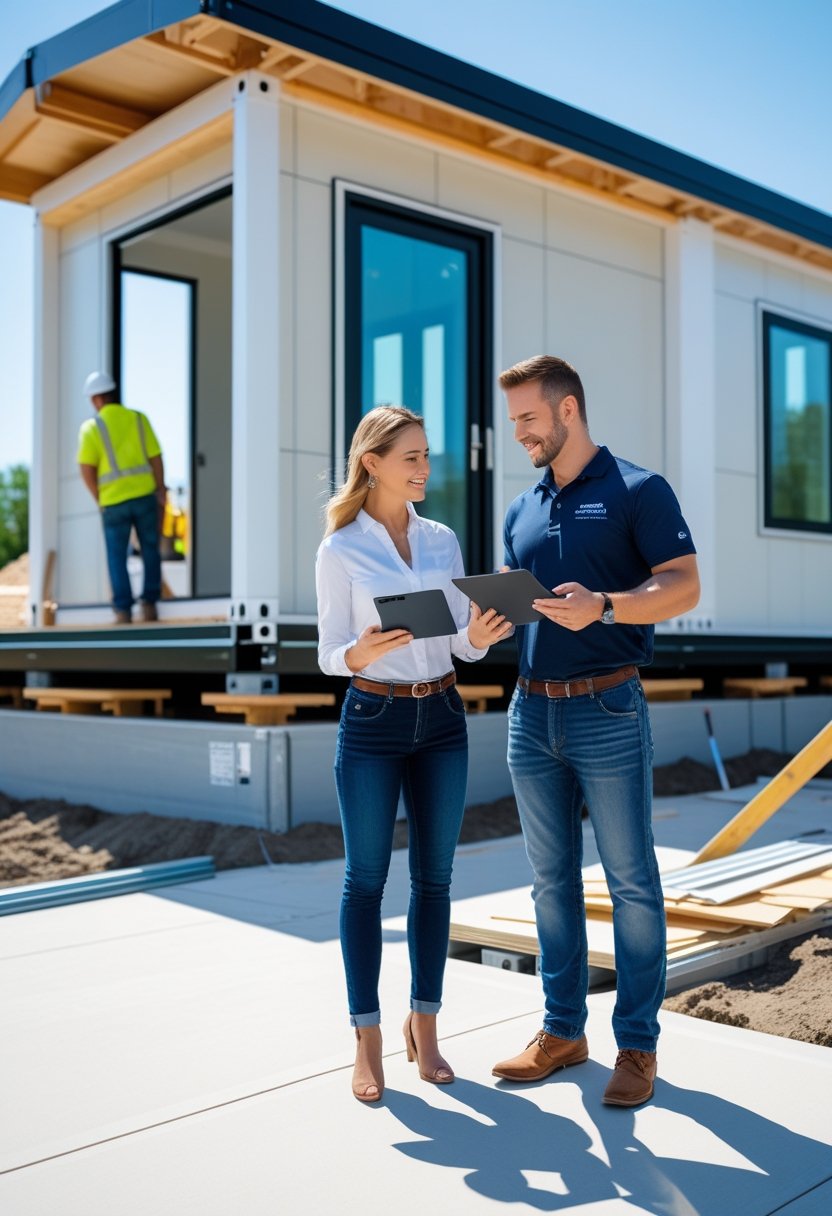
Getting the right financing helps you manage costs and avoid delays when building a modular home. You need to understand how a construction loan differs from a standard mortgage and how lenders handle each stage of the process.
Construction Loans vs. Mortgages
A construction loan funds the building phase of your modular home. It usually has a short term—often six to twelve months—and releases money in stages as construction progresses. These payments, called draws, cover costs such as materials, labor, and transportation of modules to your site.
Once your home is set on the foundation and inspected, the construction loan often converts into a permanent mortgage. This is known as a construction-to-permanent loan, which simplifies paperwork and saves on closing costs.
Interest rates for construction loans may be slightly higher than traditional mortgages because lenders take on more risk during the build. You can learn more about how this two-stage process works from Nine Mistakes to Avoid When Financing a Modular Home.
When planning your budget, include expenses like land preparation, permits, and insurance. These costs are not always covered by the loan but are required before the lender releases funds.
Role of Mortgage Lenders in Modular Home Purchases
A mortgage lender plays a key role in approving and managing your modular home financing. Lenders evaluate your credit score, income, and debt-to-income ratio to determine how much you can borrow. They also verify that the builder and project meet all lending requirements.
Some lenders specialize in modular home financing and understand the construction timeline better than others. Choosing a lender with modular experience can make the process smoother and prevent funding delays.
You can compare different loan programs—such as FHA, VA, or USDA loans—through lenders familiar with modular housing. These programs may offer lower down payments or flexible credit requirements.
Before signing, review the loan terms carefully. Ask about interest rate locks, draw schedules, and conversion conditions. As explained in Financing Modular Homes: Everything You Need To Know, clear communication with your lender helps ensure your loan stays on track from construction through final mortgage approval.
Legal and Contractual Considerations
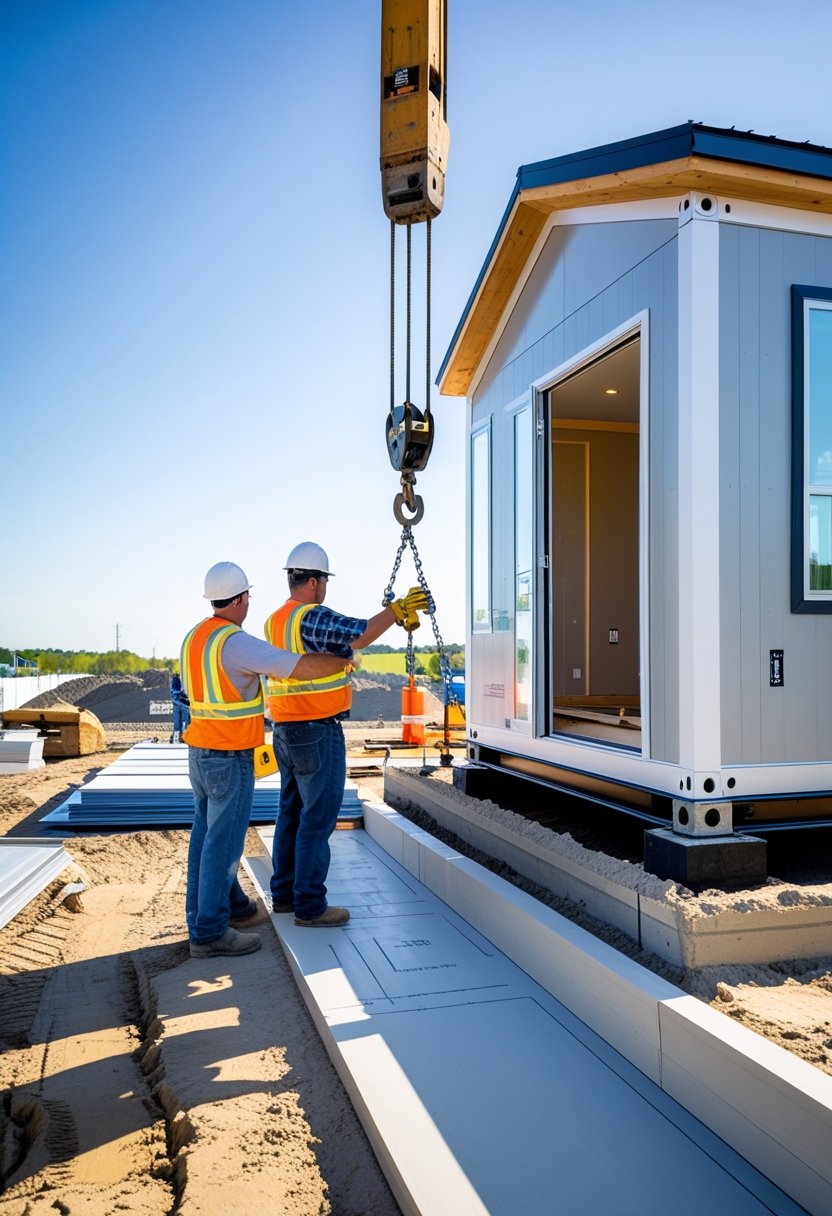
Clear contracts and proper payment handling protect you from financial loss and construction disputes. Written agreements, escrow use, and careful inspection before final payment ensure that your modular home meets all standards and legal requirements.
Key Clauses to Include in Contracts
Every modular home contract should be in writing to meet the Statute of Frauds for modular construction agreements. This law requires contracts involving real estate or long-term projects to be documented to remain enforceable.
Include specific details such as:
- Scope of work — materials, design specs, and installation steps.
- Payment terms — clear milestones tied to progress.
- Timeline — with penalties for delays or incomplete work.
- Warranties — coverage for structural defects or poor workmanship.
Make sure both parties sign and date each page. This prevents disputes about changes or missing pages. A real estate attorney can review the contract to confirm that your rights and payment protections are clearly stated.
Escrow and Payment Timing
Using an escrow account ensures your funds remain secure until the factory meets its obligations. You deposit payments into a neutral account managed by a third party, which releases money only when agreed milestones are met.
Avoid paying the full factory cost upfront. Industry experts emphasize that you should not pay before the modular home is set on the foundation because it removes your leverage if defects or delays occur. According to Modular Home Loan, tying payments to verified progress protects you from incomplete or damaged deliveries.
Typical payment stages include:
| Stage | Description | Payment Released When |
|---|---|---|
| Deposit | Contract signed | Small percentage |
| Factory build | Modules completed | After inspection |
| Delivery | Modules arrive | After condition check |
| Final | Home set and inspected | After approval |
Protecting Your Investment
You maintain control by linking payments to verified performance. Always inspect your modular home after delivery and before final payment. Hire an independent inspector to confirm alignment, structural soundness, and utility connections.
Keep written proof of inspections, communications, and approvals. If the factory fails to meet specifications, withhold payment until issues are resolved. This approach aligns with key legal considerations for modular construction contracts, which stress defining governing law and dispute resolution methods.
A well-structured contract and cautious payment process prevent unnecessary risk and keep your modular home project compliant and financially secure.
Comparing Modular Homes to Stick-Built Homes
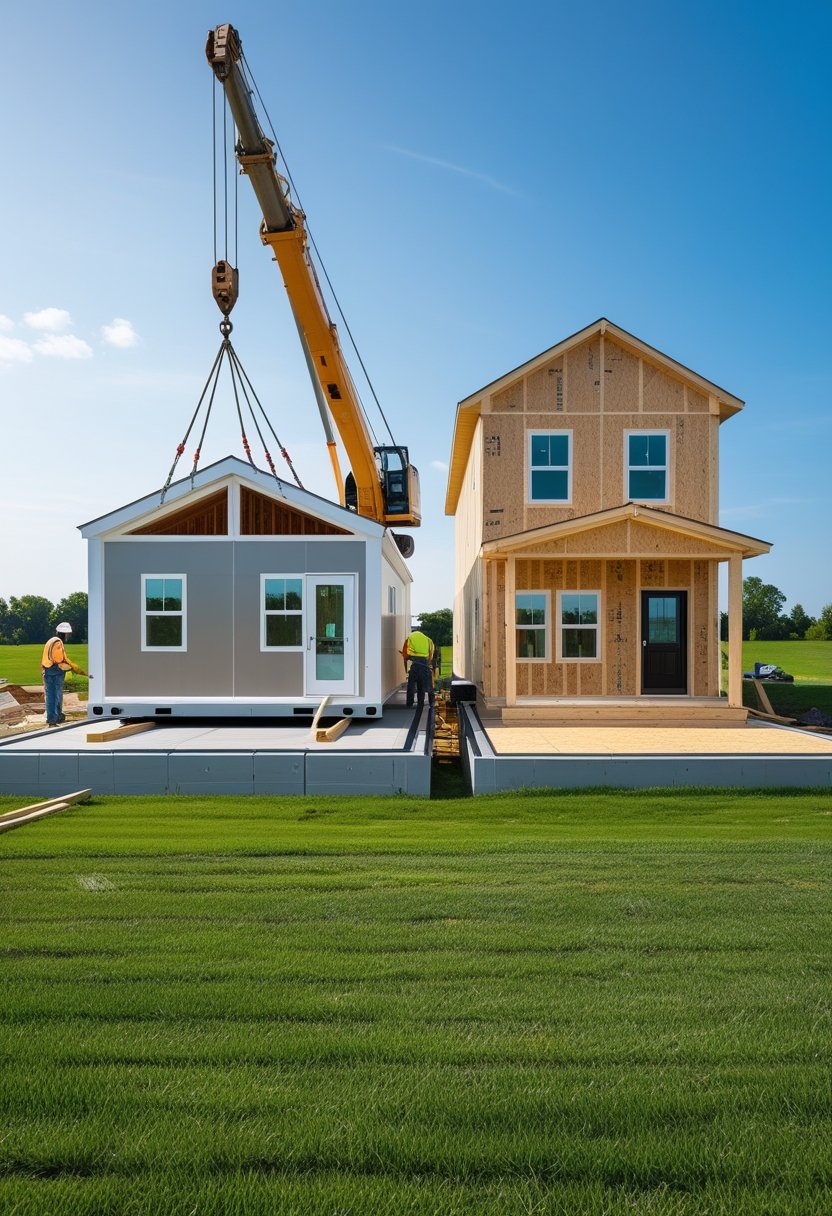
Understanding how modular homes differ from stick-built homes helps you make informed decisions about cost, quality, and construction timelines. Each method offers unique benefits and potential drawbacks depending on your priorities, budget, and schedule.
Construction Differences
A stick-built home is built entirely on-site, piece by piece. This process allows flexibility but exposes materials to weather delays and damage. In contrast, modular homes are built in sections, or modules, inside a climate-controlled factory before being transported and assembled on your foundation.
Because factory construction is standardized, modular homes often follow strict quality checks at each stage. The modules arrive with wiring, plumbing, and insulation already installed, which shortens on-site work.
| Feature | Modular Home | Stick-Built Home |
|---|---|---|
| Location of construction | Factory-built | Built on-site |
| Weather delays | Minimal | Common |
| Customization | High, but within design limits | Fully customizable |
| Inspection process | In-factory and on-site | On-site only |
You can learn more about the building process for modular vs. stick-built homes and how each approach affects project control and timing.
Quality and Durability
Modern modular homes meet the same local building codes as traditional houses. Because they’re built indoors, materials stay dry and protected from warping or mold. This controlled environment often leads to consistent construction quality and tighter joints once assembled.
Stick-built homes depend more on the skill of the on-site crew and weather conditions during construction. While both types can last for generations, modular homes benefit from factory precision and repeated quality checks.
High-quality materials, proper assembly, and regular maintenance ensure both types of homes remain durable. As noted by Ohio Cabin and Structures, modular homes today can match or exceed the strength and longevity of site-built homes.
Cost and Time Savings
You typically spend 10–20% less on a modular home than an equivalent stick-built home. Controlled production reduces labor costs and waste. Builders can also prepare the foundation while your home’s modules are being built, which shortens the total timeline.
A modular home can often be ready in about four months, compared to six months or longer for a stick-built home. Faster completion means fewer financing costs and less uncertainty.
However, transportation and crane setup fees can slightly offset savings. You can review cost comparisons and timelines in detail at New Home Source to understand how these factors affect your overall budget.
Common Problems and Pitfalls in Modular Builds
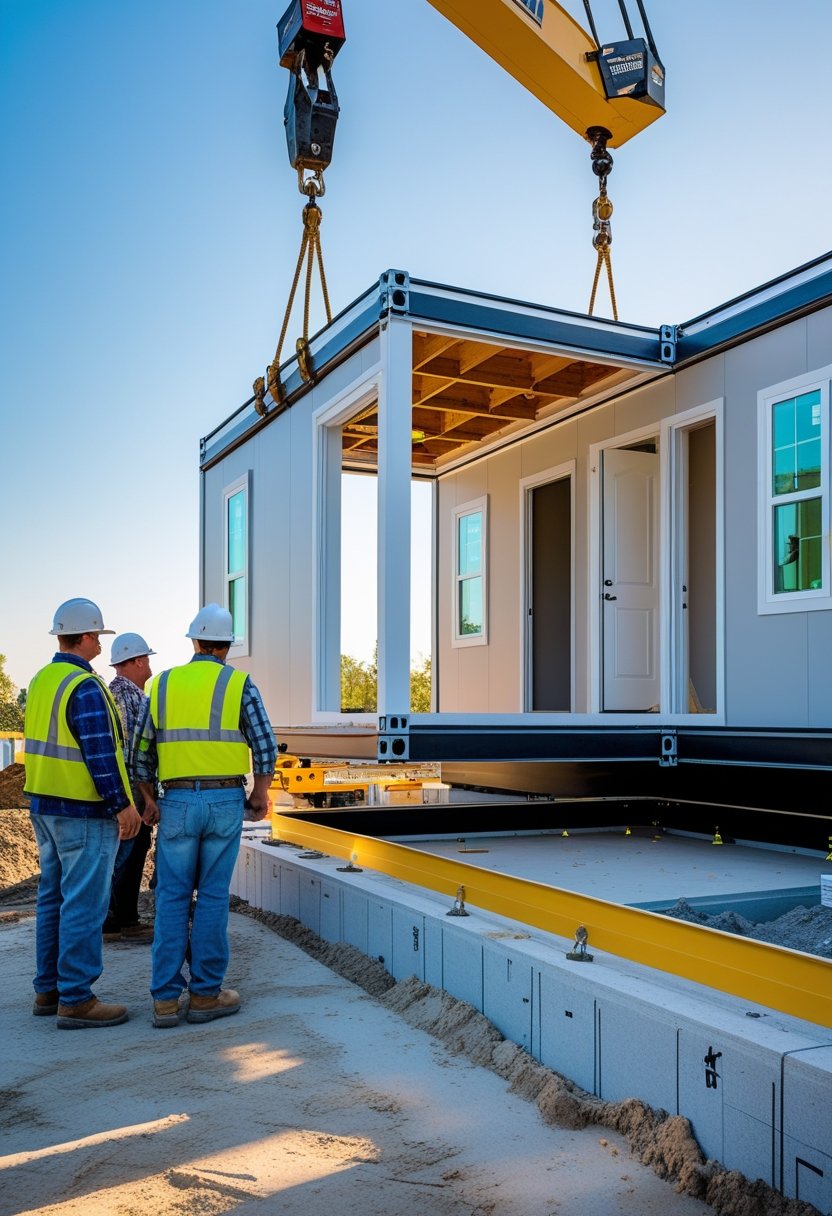
Building a modular home can save time and money, but several key steps can cause problems if not handled carefully. Land preparation, module delivery, and customization choices often determine whether your project runs smoothly or faces costly delays.
Site Preparation Issues
Before your modular build begins, the site must be level, stable, and ready for installation. Poor grading or drainage can lead to shifting foundations and water damage later. You should confirm that the soil can support the structure and that utility connections are in place.
Common mistakes include skipping a professional land survey or underestimating the cost of excavation. Even small misalignments can prevent modules from fitting correctly. According to Green Building Elements, improper site prep often causes delays and added expenses because crews must adjust foundations or rework sections on-site.
A simple checklist helps:
- Check soil compaction and drainage patterns.
- Verify utility access for water, power, and sewage.
- Confirm foundation height matches factory specifications.
Delivery and Assembly Challenges
Transporting modular homes from the factory to your property can be complex. Each section travels on large trucks that must navigate local roads, bridges, and weight limits. If access is tight or the route is restricted, delivery can be delayed or damaged in transit.
Once modules arrive, they must be precisely aligned and secured. Even a small foundation error can create gaps or stress points that affect structural integrity. Builders often use cranes to set each section, and weather can halt the process if wind or rain makes lifting unsafe.
The Fine Line Homes guide notes that poor coordination between transport and assembly teams can lead to miscommunication and extra costs. You can reduce risks by confirming delivery routes, scheduling experienced crews, and verifying measurements before installation.
Customization Limitations
Modular homes follow factory-built designs, which means your customization options are more limited than with traditional construction. Walls, windows, and layouts must fit within the module’s structural frame, so major design changes can be difficult or expensive.
You can usually choose finishes, colors, and fixtures, but altering the floor plan often requires new engineering approvals. The EkoBuilt review explains that modular homes use standardized components, which restricts flexibility but helps maintain quality control.
When planning your modular build, balance your design goals with what the manufacturer can realistically provide. Ask for detailed specifications early and confirm what modifications are possible before production begins.
Resale Value and Long-Term Investment

When you buy a modular home, its long-term worth depends on how well it holds value, how the market views it, and what factors affect its resale price. Understanding these details helps you make smarter financial decisions and protect your investment.
Modular Home Resale Value Compared to Other Homes
A well-built modular home can sell for about the same price as a traditional stick-built home. The key is that modular homes are placed on permanent foundations and meet the same building codes as site-built houses. Because of this, banks and appraisers treat them similarly during resale.
According to the Modular Home Builders Association, modular homes often appreciate at rates comparable to traditional homes. This happens because they are built with high-quality materials in controlled conditions, reducing construction errors and long-term maintenance issues.
Buyers often find modular homes appealing because they combine affordability with durability. If your modular home is in a desirable neighborhood and well maintained, its resale value can match or even exceed that of nearby conventional homes.
| Type of Home | Typical Value Trend | Financing Availability |
|---|---|---|
| Modular Home | Appreciates like site-built homes | Standard mortgages available |
| Manufactured Home | Often depreciates over time | Limited financing options |
Market Perception and Appreciation
Public perception plays a large role in modular home resale. Many people still confuse modular homes with mobile or manufactured homes, which can depreciate. Educating potential buyers about the difference can help maintain value and attract better offers.
Modern modular homes are built to the same standards as local building codes, making them comparable in quality and appearance to traditional homes. As more buyers understand this, the market perception continues to improve.
Studies, such as those discussed by HomeGrail, note that location and upkeep strongly influence appreciation. When placed in stable or growing housing markets, modular homes appreciate at similar rates to conventional properties.
Over time, as modular construction becomes more common, the stigma fades and resale potential strengthens.
Factors Influencing Resale
Several factors affect modular home resale value. Location remains the most important—homes in areas with strong demand and good schools tend to sell for higher prices. Maintenance also matters; a well-kept modular home signals quality to buyers.
Customization and upgrades can increase resale value. Adding energy-efficient windows, updated kitchens, or modern finishes can make your home more competitive.
Age and condition influence price as well. While modular homes age similarly to traditional ones, neglect or poor installation can reduce appeal.
Finally, foundation type and financing accessibility make a difference. Homes built on permanent foundations qualify for standard loans, which helps maintain value compared to movable or temporary structures.
Tips for Safe Modular Home Purchases
You can protect your investment by choosing reliable builders, confirming quality at every stage, and managing payments wisely. Careful planning and clear agreements reduce the risk of delays, defects, or financial loss when buying a modular home.
Working with Reputable Manufacturers
Choose a licensed and experienced manufacturer with a proven track record. Look for companies that follow state and local building codes and have clear documentation for their modular homes. Reading customer reviews and checking references can help you confirm their reliability.
Ask for a written contract that lists materials, timelines, and warranty terms. Reputable builders, such as those mentioned in ConsumerAffairs’ guide to modular homes, clearly explain costs and responsibilities.
Avoid paying large deposits before production begins. A trustworthy company will request reasonable installments tied to progress milestones.
You can also verify certifications from third-party inspectors or industry associations. These credentials show the builder meets recognized safety and quality standards for modular housing.
Inspection and Quality Assurance
Inspect every stage of construction before your modular house leaves the factory. Many issues—such as poor sealing or wiring errors—are easier to fix before transport. Some buyers hire independent inspectors to ensure the home meets local codes and manufacturer specifications.
When the modules arrive, confirm that they are properly aligned and anchored to the foundation. According to Prefabie’s overview of modular home safety, a strong foundation and correct installation are key to long-term durability.
Keep a checklist for inspection points:
| Area | What to Check |
|---|---|
| Structure | No cracks or warping |
| Electrical | Correct wiring and labeling |
| Plumbing | Leak-free connections |
| Insulation | Even coverage, no gaps |
Document all findings and request corrections before moving forward.
Final Payment Best Practices
Never release the final payment until your modular home is set on its foundation and passes inspection. This step ensures the builder completes all contracted work and resolves any issues.
Use a payment schedule that links each payment to a verified milestone. For example:
- Deposit after contract signing
- Second payment after factory build completion
- Final payment after installation and inspection
The Welcome guide on modular home costs warns that unexpected foundation or setup expenses can arise. Confirm all fees in writing before paying.
Keep copies of receipts, inspection reports, and communications. These records protect you if disputes occur later.
Conclusion and Key Takeaways
You should never pay for a modular home before it’s placed on its foundation because payment timing protects your investment. Once the home is set, you can confirm that materials, workmanship, and installation match what you agreed to.
Key reasons to wait:
- You keep control over the project timeline.
- You can verify that the builder met quality standards.
- You reduce the risk of losing money if delays or damage occur.
Many experts note that modular homes offer faster construction and lower costs than traditional builds, but they still require careful planning and payment control. According to Homes Direct, modular housing can provide affordability and quality, yet financing and setup can be complex.
Checklist before making final payment:
| Step | What to Confirm | Why It Matters |
|---|---|---|
| Delivery | All modules arrived undamaged | Ensures full structure is ready |
| Setup | Home is properly aligned and secured | Prevents long-term structural issues |
| Inspection | Local code compliance verified | Confirms safety and legal approval |
| Contract | Terms and warranties reviewed | Protects your rights as a buyer |
By following these steps, you maintain control and confidence in your purchase. Paying only after the home is set and inspected ensures you get what you paid for—nothing less.
Frequently Asked Questions
Paying for a modular home before it is set on its foundation can expose you to financial and structural risks. Understanding how payment timing, foundation quality, and installation standards affect your investment helps you protect your money and ensure your home’s long-term stability.
What are the risks of paying for a modular home before it is placed on the foundation?
If you pay before the home is installed, you lose leverage to ensure quality and completion. The factory may delay delivery or overlook issues during manufacturing or transport. According to Modular Home Loan, waiting until the home is set safeguards your investment and ensures compliance with agreed standards.
What are the common issues faced after purchasing a modular home?
After installation, you might notice settling, misalignment, or small leaks. These problems often result from improper setup or poor site preparation. Regular inspections and maintenance can help prevent long-term damage and preserve your home’s condition.
How can you verify that a modular home is properly set on a permanent foundation?
Hire a licensed inspector to check that the modules align correctly and utilities connect securely. The home should meet local building codes and show no visible gaps or structural shifts. A professional inspection before releasing final payments confirms the factory met its obligations.
What are the financial implications of modular homes in terms of depreciation?
Modular homes generally hold value similarly to traditional homes once permanently affixed to land. However, if the home is not set on a legal foundation, it may be treated as personal property and depreciate faster. Proper installation ensures it qualifies as real estate for financing and tax purposes.
What considerations should be made when choosing a foundation for a modular home?
Select a foundation type suited to your soil and site conditions. Options include slab, crawl space, and basement foundations. As explained in Modular Home Loan’s guide, soil stability, drainage, and local codes all influence which foundation design will best support your home.
How do the costs of setting a modular home on a foundation compare to traditional home-building expenses?
Setting a modular home on a foundation usually costs less than building a full home on-site because much of the structure is factory-built. However, foundation work, transportation, and crane setup can still be significant expenses. When managed properly, the total cost remains lower than traditional construction while maintaining quality.

